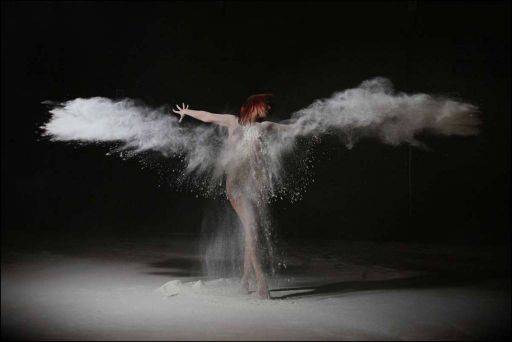Dust Storm

THINKING:
Shooting with flour can be a random process, but that should not stop you going in with pre-visualised photographs in mind.
I knew from past experience that this sort of outward thrust can work well and it was one of the (many) images we created.
SEEING:
Very graphically simple, just a stretched T shape. But part of the beauty and strength of this image is its compositional simplicity.
It was fortuitous that the flour happened to fall in a way that left the figure hidden. It is more interesting for not having a nude clearly visible within the dust cloud.
DOING:
Lighting is from one side only. Sidelight or even backlight really helps reveal the form and density within the dust cloud. Flash lighting is required to really freeze the motion of the flour.
You can use many alternatives to flour: milk powder works well; talcum powder is less dense so cannot be thrown so far away, but does give good clouds. I often shoot with a mixture of all three.
Protect your camera - it will get dusty no matter how far away you are. I put the camera in a plastic bag except for the lens and I have wrapped light sources in large plastic sheets used by painters and decorators.
Clean up of the powder is slow and tedious. Crucially it must not get wet. As soon as flour gets wet it becomes super gloopy and sticky. The model needs to dry towel off as much flour as possible from the body and in particular the hair.
share:
This is an excerpt from "Art Nude Photography Explained" which shows you how to create nude images and how to read and evaluate art nude photographs
It is available on Amazon
or on
the store